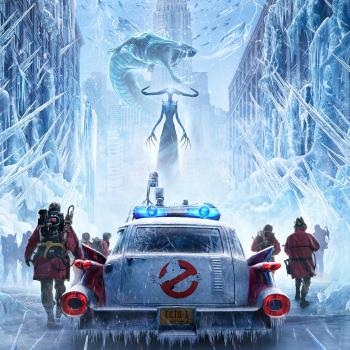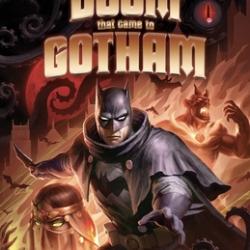Review of Sleepy Hollow Season Finale (Episodes 12 & 13)
The Apocalypse is one step nearer as Moloch prepares to break the second seal and release the Second Horseman upon humanity. Only a secret message hidden in the pages of George Washington’s Bible (written by Zombie George Washington himself!), combined with magic sin-filled prayer beads and the ancient Masonic art of finding hidden tombs, can reveal the map to Purgatory. With the map, Ichabod and Abbie can free Ichabod’s trapped wife Katrina the Quaker Witch, who can cast the spell that will keep the Second Horseman in his prison where he belongs. In case this wasn’t a big enough bucket of crazy, the map to Purgatory was hidden in George Washington’s tomb (his real one—not the one for tourists at Mount Vernon), which happens to be right outside of Sleepy Hollow. Also making an appearance are ley lines and the Apocrypha of John because why not?
There are two major themes that pop up in this episode (both of which themes are likewise found in a similar—if better—show called Supernatural). The first is the theme of free will vs. determinism. Are we actors living out a pre-scripted Divine drama, with cues and guides and lines all set up for us, or do we create our own destiny? A fairly common theme in this sort of television (see again Supernatural) is the idea that there is a divine plan for us, and that we need to shrug off that plan in favor of pro-humanity free will. In this episode, for example, Ichabod boldly declares “We have free will, and I choose to forge my own fate with you.”
Unfortunately, this wasn’t a very well developed theme in the context of the full season of Sleepy Hollow. All along, Ichabod and Abbie have been following the guidance of a clearly benevolent Providence set out both two hundred years before by George Washington and over the previous decade by the now-deceased Sheriff of Sleepy Hollow—more than that, they’ve eagerly embraced their role as ‘witnesses’ per the prophecies of ‘Revelations’, and have accepted at face value the reliability of other prophecies detailing the various villains of the week and their many shenanigans. This sudden ‘declaration of independence’ by Crane seems out of place and forced—almost as if it were put there as an obligatory nod to a common television trope rather than as an actual plot essential. (If you want to know more about free will, we’ve discussed it in detail elsewhere on this blog.) 
The second theme that is worth noting is the depiction of Purgatory. (Again, see Supernatural.) Purgatory is a useful device for several reasons. First, no modern American really knows anything about it, so it becomes a blank paper that can be filled in by whatever beings or events the writers want. They can draw from the whole spectrum of cultural myths without having to worry about offending anyone’s sensibilities or preconceptions and do so in a way that is at least somewhat coherent and consistent with the plot. (A similar device is the use of alternate realities in science fiction—a device which I find fairly annoying.) Second, Purgatory is much easier to use as a symbol for our own world than the presumably always-pleasant heaven or always-awful hell, both of which don’t line up with our own mixed experiences of pain and pleasure in this life.
Finally, and most importantly, Purgatory provides an opportunity to explore a transcendent reality without requiring anyone to either talk about God (heaven) or make the moral judgments implied by the existence of a hell. In other words, in the hands of TV writers Purgatory becomes the modernist’s dream—an afterlife with no God and no judgment and a way to make definitive statements that generally offend no one and say nothing of substance (e.g. that there is an afterlife, and that it might not be a nice one, but it also might be). In the case of Sleepy Hollow, [spoiler alert] the trials of Purgatory are only overcome when Abbie and Ichabod remember and are faithful to their friendship and their responsibility to the human race. And when the big lessons of Purgatory are such shallow platitudes as “don’t betray your friends” and “don’t let the human race be exterminated” with no reference to God and no need for any kind of inner reform, we know that something has gone wildly askew.
Now, as a good Reformed Evangelical, in some sense I have no dog in this fight. There is no Purgatory either laid out in Scripture or demanded by logic—in fact, it’s quite the opposite. The doctrine of the atonement declares that all of our sin is paid for completely and totally on the cross and that no further satisfaction is required by God. There need be no waiting room where our remaining sins are purged because every needful thing has been done by Christ (though we can see why the church fathers would have speculated about such a thing).
With that said, the cranky old man in me still blanches a bit at the way Purgatory gets thrown around these days. Consider what Dante* says about Purgatory:
I shall sing about that second realm
Where man’s soul goes to purify itself
And become worthy to ascend to Heaven. (Dante, Purgatorio, trans. Mark Musa, New York: Penguin Classics, 1985. I.4-6.)
This view of Purgatory is of a place where man’s soul is purified and made worthy by Divine grace, where humanity undergoes the moral development it should have pursued here on earth in order to be prepared for the Presence of God. Obviously, this is at odds with the Sleepy Hollow‘s presentation of Purgatory as a place where the virtue needed to triumph is focused entirely on humanity. Not only is man in need of no moral refinement, the message seems to be that he is good already and only needs to remember to tap into that inner goodness. Purgatory has ceased to be a place of purgation of sins and has become a place of celebration of man—and not a man of very deep or complex morality at that.
But that of course is also where the cranky old man in me has to stop shouting at the kids on the lawn, because we do not need to go back to the older view of Purgatory. In a sense, both views of Purgatory are useful because both reveal the false theology dominant at the time. In Dante’s day, a view of salvation by works was prevalent (but not universal) and so the Purgatorio was the result; in our day, a view of man as not needing salvation at all is prevalent, and so the use of Purgatory as a place of neutral transcendence is beginning to dominate. So while my traditionalist side wishes these darn Hollywood people would just get it right, I also realize that in saying that I’m demanding that television choose an older heresy over a newer one. And once it’s phrased like that, I can at least begin to appreciate the value of the device of Purgatory as a window into the culture of our times as much as it was for Dante’s.
All of that is not to say that Sleepy Hollow has not been a delight to watch! As you might have picked up from the opening paragraph of this review, this show is insane, and I am very much looking forward to the next season if only to see how the insanity continues.
*If you haven’t read Dante yet, you should. I recommend either the Ciardi or the Musa translations, though the Esolen, Sayers, and Mandelbaum versions are quite good as well. Avoid Pinski.
Dr. Coyle Neal is Assistant Professor of Political Science at Southwest Baptist University in Bolivar, MO, which is surely somewhere on the mount of Purgatory, even if the exact terrace can be hard to pin down.












